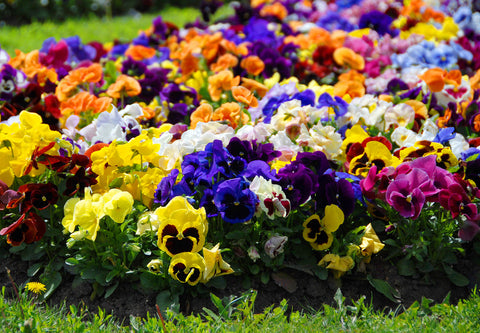
Colourful Winter Gardening with Pansies and Violas
Share
Bring some joy to your winter garden with these special flowers which are extremely easy to grow! They come from the ancient Viola species which has more than five hundred species. The name pansy is derived from the French word pensée meaning "thought", and refers to the flower because it looks like a human face, nodding in thought. Pansies have bigger faces and leaves than their cousin, the viola, which is also known as Johnny Jump Up or Heart's Ease.
Both pansies and violas brighten up an early spring garden with their multi-coloured faces that are delicately perfumed and edible too. The blooms offer a soft, sweet fragrance that is most noticeable in the early morning and at dusk. For those of you who want to plant pansies for their smell, choose yellow or blue blooms; they have the strongest scent.

The main difference between the two is flower size. Pansies generally have fewer blooms per plant, but make up for it with much larger flowers. Violas have small, dainty flowers, but they are very florific. Both perform well in a sunny or partially shaded position, so planting under deciduous trees in autumn is ideal. Violas are even happy in quite shady positions, so they are perfect for brightening up dull areas. If we happen to experience a hot, late summer, be sure to mulch well around your newly planted seedlings as they don’t like warm soil.

Set out your seedlings 20cm apart as soon as the weather cools and you’ll enjoy them for many months to come. Pansies and violas are suitable for the front of borders and beds, in small groups among other flowers, as well as in containers. Pansies come in a wide variety of colours including yellow, gold, orange, purple, violet, red, white, and even black (very dark purple) while violas have smaller leaves and blooms in yellow, cream, purple, violet and even black.
They can survive light freezes and in mild climates bloom throughout winter and spring, often blooming right up to Christmas. For the best performance; water thoroughly about once a week, depending on the amount of rain you receive, but remember to water the soil around the plants not the leaves. To maximize blooming, use a plant food every other week and don’t forget to deadhead to extend the blooming period.

Watch out for stem rot which is also known as pansy sickness and is a fungus linked to unsterilized animal manure. In damp, airless gardens, mildew can occur. Symptoms include violet-gray powder on fringes and underside of leaves. Also, watch out for cucumber mosaic virus which is transmitted by aphids. Plants with the virus have fine yellow veining on young leaves and stunted growth. Spray your plants with a soapy water to keep aphids at bay and keep slugs and snails away from the leaves with a mulch of gritty sand or bark chips.
Violas and pansies have stood the test of time because they are generous, easy to grow and very rewarding. Don’t let this winter pass by without the colourful companionship of these precious flowers.
